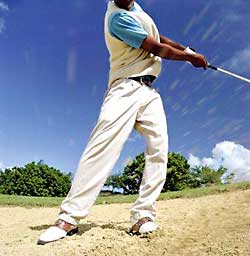 Then approaching the green, most seasoned golfers prefer to chip rather than pitch. This means they are more comfortable playing a relatively low shot and run the ball up the pin, rather than hitting a higher lob shot that lands close to the pin and stops immediately.
Then approaching the green, most seasoned golfers prefer to chip rather than pitch. This means they are more comfortable playing a relatively low shot and run the ball up the pin, rather than hitting a higher lob shot that lands close to the pin and stops immediately. The reason for this is that the former is a good percentage shot, and the latter is much harder to execute consistently with a much larger margin for error. However, every so often during a round, there will be situations where there is not much green to work with or there is a heavy rough, water or perhaps even a deep bunker to clear.
In these instances, a low running chip shot is not an option. The only shot is the high flying, soft landing pitch. Even though the percentages are against executing this shot well, and the risks of taking this option are high, there is no choice but to play it. This is something every golfer needs to have in order to improve their score. If you know the proper technique and practice it, you will soon feel comfortable using it on the course when necessary.
To play this type of shot, you must be able to create elevation in your shot, and for that you require to follow two main criteria:
First, lay the clubface a little open before taking your grip, which ensures there will be enough elevation when you hit down on the back of the ball.
Second, open your stance with the feet, shoulders, and hips aiming left of the target. This allows you to swing freely on your follow through. Ensure the clubface aims at the pin. Keep the ball forward in your stance (more towards the left foot).
Once your address position is correctly set, then commit to taking your back swing on the line of the feet. Unlike other swings, you have to hinge your wrist more to be able to create a steep angle of attack on the downswing. This is what gives the height on the shot. Ensure the down swing returns on the same path as the backswing. It should feel as though you're swing is well left of the target. The key to this shot is to hold the clubface open through impact with the grooves facing the sky. If you follow these instructions, keep your rhythm smooth and put in a little practice, there's no reason why you shouldn't be able to play this shot well.
Know your rules:
Q. At a par 3 hole, A had hit his first tee shot into the woods and hits a provisional ball, which lands two feet from the flag. However his caddy and the gallery who had already gone to search for the ball, had found a ball within the permissible 5 minute search time, but the ball was not yet identified as belonging to A. A wanted to declare his first ball as lost ball. Is this permissible?
A. In this circumstance, A must identify the ball which has been found, and if that is his ball, he should continue to play with that ball. However if that was not his ball, only then is he allowed to continue play with the provisional ball.
Deepak Acharya is a golf instructor and Head Golf Professional at Gokarna Forest Golf Resort & Spa, Kathmandu. [email protected]



